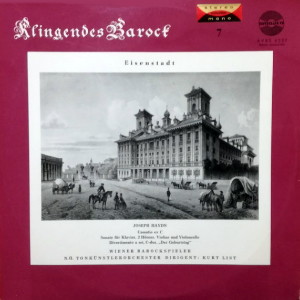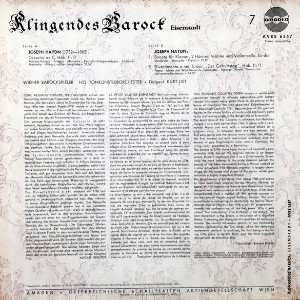 |
1 LP -
Amadeo AVRS 6357
|
 |
|
| EISENSTADT -
Klingendes Barock - 7 |
|
|
|
|
|
| Joseph Haydn
(1732-1805) |
|
|
| 1. Cassatio ex C,
Hob. II:17 |
27' 34" |
A1 |
| - Marche/Adagio
· Allegro ·
Recitativ/Allegro/Adagio · Andante
· Menuetto · Allegro molto ·
Andante |
|
|
2. Sonate für
Klavier, 2 Hörner, Violine und
Violoncello, Es-dur *
|
10' 49" |
B1 |
| - Moderato ·
Menuetto · Presto |
|
|
| 3. Divertimento a
sei, D-dur, "Der Geburtstag", Hob.
II:11 |
14' 53" |
B2 |
| - Presto ·
Mann und Weib/Andante (moderato)
· Menuet · Finale: Thema con
variazione/Moderato |
|
|
|
|
|
WIENER
BAROCKSPIELER *
|
N.
Ö. TONKÜNSTLERORCHESTER |
|
|
Kurt List, Dirigent |
|
|
|
|
|
Luogo
e data di registrazione |
|
-
|
|
|
Registrazione:
live / studio |
|
studio |
|
|
Edizione LP |
|
AMADEO
- AVRS 6357 - (1 lp) - durata 53'
16" - (p) 1966 - Analogico |
|
|
Altre edizioni
LP
|
|
MUSICAL
HERITAGE SOCIETY - MHS 544 - (1
lp) - (1, 3)
MUSICAL HERITAGE
SOCIETY - MHS 524 - (1 lp) - (2)
|
|
|
Prima Edizione
CD |
|
- |
|
|
Note |
|
Stereo
compatible
|
|
|
|
|
THIS
PLEASANT COUNTRY-TOWN
anjoys a world-wide
reputation through its
intiate association with
Joseph Haydn, who spent
many years there in the
service of the house of
Esterhazy. He was
appointed Kapellmeister at
the Eisenstadt Court in
1761, became one of the
greatest figures in the
whole history of music,
and eventually came to his
last resting-place in the
Bergkirche at Eisenstadt.
The
exact date of this
Cassatio is unknown, but
Hoboken assigns it to a
date earlier than 1766.
It opens with a
ceremonial March and
ends with a movement
based on a pigrims'
song. In between there
are two minuets, the
first easy going and the
second more courtly, two
Allegri, the first
worked out with meticulous
precision and the
second in gay
Divertimento style;
and a Cantilena for
strings only, preceded by
a Recitativo.
The
Sonata in E
flat dates from
the early Eisenstadt
years, probably 1766,
though the original
version is no longer
extant. Elssler's
catalogue lists it as a
Divertimento.
Essentially the work
belongs to the early
classical period, the
second of the three
movements being a Minuet
instead of a slow
movement. The thematic
material is largely
determined by the range
and scope of the horns,
which give the work a
hughky individual
flavour.
The
Divertimento a Sei
dates from about 1760
and seems to have been
very popular during
Haydn's lifetime,
as copies of it in
manuscript were
widely distributed,
though the works was
never printed in its
original form. It
has been
reconstructed from a
number of 18th
century sources by
the well-known Haydn
expert Robbins
Landon. The work is
particularly
interesting as
combining the
typical Divertimento
style of Haydn's day
with a sort of
"programme", namely
the confrontation of
the two sexes. Why it was
called "Der
Geburtstag" (The
Birthday) is not
known. The best
movement is the
Finale, a
discussion of a
dignified theme
illustrating the
characteristic
qualities of male
and female. The
second movement
consists of two
contrasting themes
representing the
two sexes, while
the remaining
movements conform
to tradition, the
first being a
charming little
piece in sonata
form, and the
third a typical
Minuet with an
attractive Trio.
Alfons Übelhör
(Translation:
Richard
Rickett)
|
|

